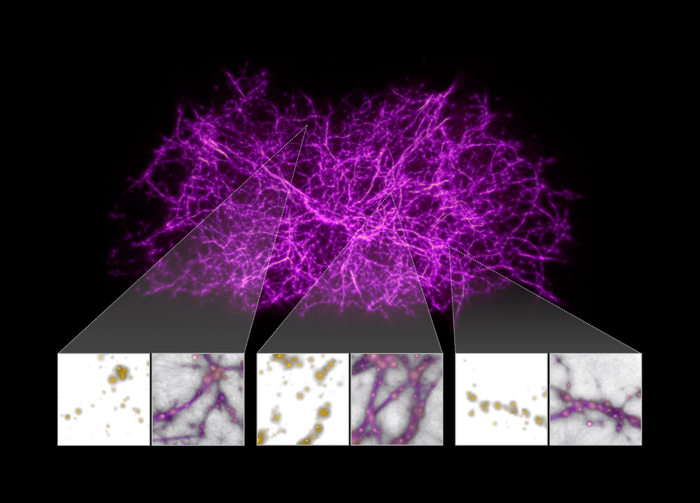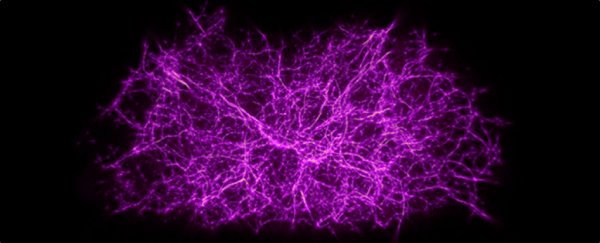Astronomers have used an algorithm based on the growth patterns of slime mould to map something that's basically impossible to see: the cosmic web of gas and dark matter underpinning the very structure of the Universe.
Slime mould (Physarum polycephalum) is one of the weirdest life forms on the planet, but we shouldn't underestimate these strange, gelatinous blobs.
That's because, despite appearances, this brainless organism – or rather the way it grows outward in branching networks of slimy tendrils – is capable of 'solving' spatial problems that are actually incredibly complex from a computational perspective.
In the past, models based on P. polycephalum's wanderlust have solved mazes, identified the shortest path between points, and even reconstructed the network of the Tokyo rail system.
Just how big does slime mould dare to dream, though? Well, the answer is "pretty big". In new research led by astronomer Joe Burchett from UC Santa Cruz, scientists found P. polycephalum's exploratory instincts stand to help solve one of the grandest unknowns in astrophysics.
 (NASA, ESA, and J. Burchett and O. Elek – UC Santa Cruz)
(NASA, ESA, and J. Burchett and O. Elek – UC Santa Cruz)
Above: The slime mould model's 3D map of the cosmic web's filament network, with insets showing galaxies (yellow) and algorithmically generated filament strands (purple).
"Modern cosmology predicts that matter in our Universe today has assembled into a vast network of filamentary structures colloquially termed the 'cosmic web'," the authors write in their new paper.
"Because this matter is either electromagnetically invisible (i.e., dark) or too diffuse to image in emission, tests of this cosmic web paradigm are limited."
In other words, how can we try to experimentally visualise this gigantic, unseeable cosmic web that serves as the scaffolding of the entire Universe, given it consists of invisible dark matter or wispy gas filaments that are difficult to make out on our scopes?
This was never really a problem for slime mould. Until it was.
One of the UC Santa Cruz team, computational media researcher Oskar Elek, was inspired by the work of German media artist Sage Jenson, who had created artistic simulations based on P. polycephalum's foraging behaviour.
The researchers took Jenson's 2D model and recreated it in three dimensions with additional modifications. They then fed the algorithm a dataset of the coordinates of 37,000 galaxies in what's known as the Local Universe, and the slime mould model did its thing: joining the dots like always, but this time on a celestial scale, giving us a virtual, optimised reconstruction of what the cosmic web might actually look like.

"The galaxies effectively serve as 'food' sources for a swarm of virtual 'slime mould' agents released into a 3D space defined by the celestial coordinates of each galaxy," the researchers write.
"The agents continually move through space and eventually reach an equilibrium state, tracing an approximate optimal transport network from galaxy to galaxy."
Of course, the 3D map the algorithm generates is only a contrived simulation – not a firm proof of where the cosmic web's dark matter and gas filaments actually reside out there in space. Nonetheless, it could be our best approximation, the researchers say, and they have at least some evidence to back that claim up.
While it would probably be impossible to validate the entire cosmic web reconstruction, spot checks comparing the slime mould's filaments with legacy Hubble data on hydrogen gas locations suggest the algorithm's network is accurate.
"We knew where the filaments of the cosmic web should be thanks to the slime mould, so we could go to the archived Hubble spectra for the quasars that probe that space and look for the signatures of the gas," Burchett says.
"Wherever we saw a filament in our model, the Hubble spectra showed a gas signal, and the signal got stronger toward the middle of filaments where the gas should be denser."
Should we be surprised that something as basic and lowly as slime mould instinct can help point us in the direction of cosmic structures that have otherwise eluded scientific discovery? Well, yes and no, the researchers say.
"It's somewhat coincidental that it works, but not entirely," Burchett explains.
"A slime mould creates an optimised transport network, finding the most efficient pathways to connect food sources. In the cosmic web, the growth of structure produces networks that are also, in a sense, optimal. The underlying processes are different, but they produce mathematical structures that are analogous."
In any case, the findings could provide us with an entirely new way of understanding the structures of the cosmic web, and largely thanks to the existence of slime mould. We are all in the gutter, it seems, but some of us are looking at the stars.
"For the first time now, we can quantify the density of the intergalactic medium from the remote outskirts of cosmic web filaments to the hot, dense interiors of galaxy clusters," Burchett says.
"These results not only confirm the structure of the cosmic web predicted by cosmological models, they also give us a way to improve our understanding of galaxy evolution by connecting it with the gas reservoirs out of which galaxies form."
The findings are reported in The Astrophysical Journal Letters.
